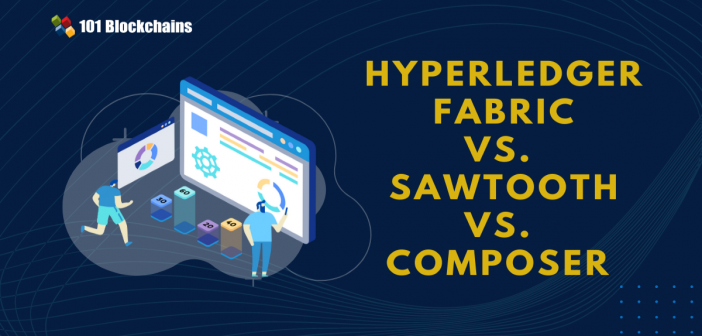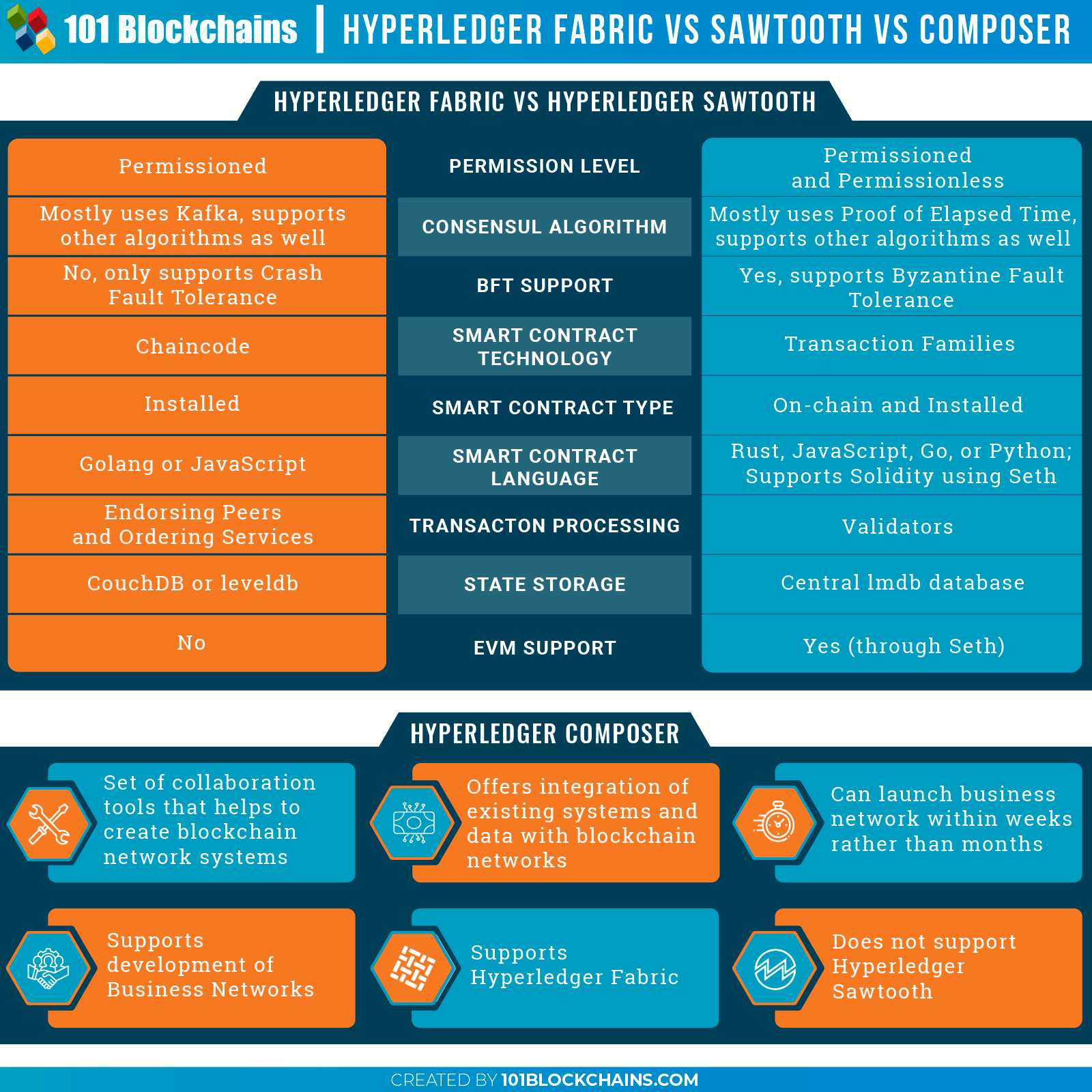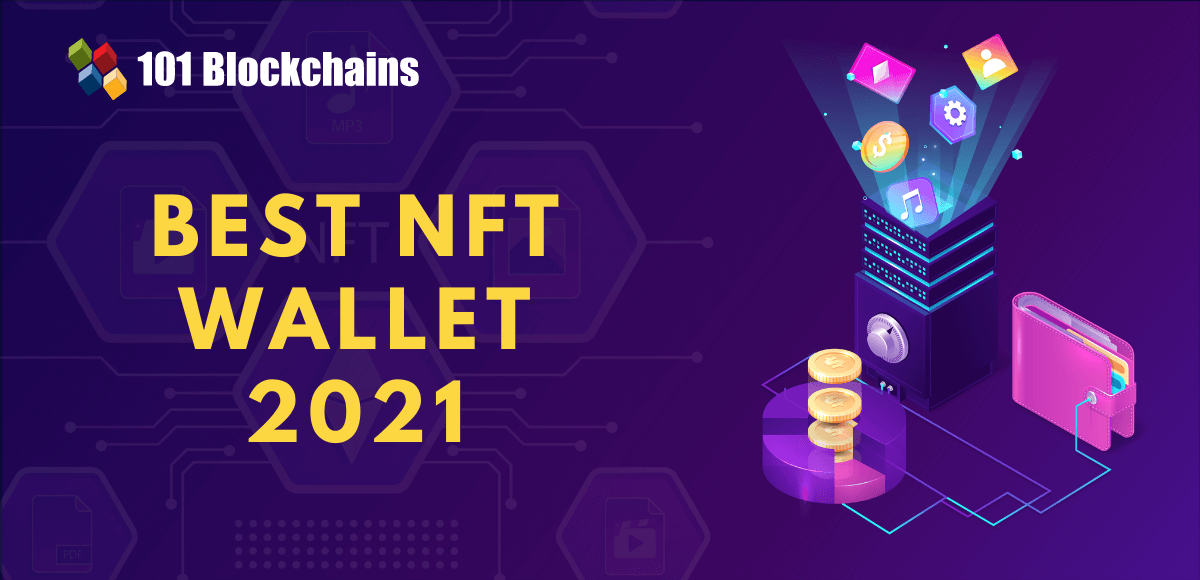Learn how blockchain truly works, master key definitions, and uncover what makes smart contracts so "smart." Dive into the fundamentals, gain valuable insights, and start your blockchain journey today!

- Reviews
Hasib Anwar
- on September 15, 2021
Hyperledger Fabric Vs Sawtooth Vs Composer
Want to understand the difference between Hyperledger Fabric vs Sawtooth vs Composer? Let’s check out the similarities and differences in this comprehensive guide now.
With the new blockchain revolution happening around the world, you must have heard the name Hyperledger. Hyperledger is one of the biggest enterprise blockchain platforms in the market. Linux Foundation is behind the idea of creating a consortium of companies for the betterment of blockchain technology. Thus, a comparison of Hyperledger Fabric vs Sawtooth vs Composer is a must now.
At present, they have a lot of projects under their wings. However, many of you are confused about how these projects differ from each other.
So, we’ll be comparing these three projects and help you to distinguish between them. So, let’s start Hyperledger Fabric vs Sawtooth vs Composer explanation!
Want to know more about Hyperledger Fabric? Enroll Now: Getting Started with Hyperledger Fabric Course
Table of Contents
Chapter-1: Hyperledger Fabric: The Pioneer of Enterprise Blockchain
Chapter-2: Hyperledger Sawtooth: Another Blockchain Milestone
Chapter-3: Hyperledger Fabric Vs Sawtooth
Chapter-4: Hyperledger Composer: The Development Tool
Chapter-5: Hyperledger Fabric Vs Sawtooth Vs Composer: All Comparisons
Chapter-1: Hyperledger Fabric: The Pioneer of Enterprise Blockchain
Please include attribution to 101blockchains.com with this graphic. <a href='https://101blockchains.com/blockchain-infographics/'> <img src='https://101blockchains.com/wp-content/uploads/2019/08/Hyperledger-Fabric-vs-Sawtooth-vs-Composer.png' alt='Hyperledger Fabric vs Sawtooth vs Composer='0' /> </a>
What is Hyperledger Fabric?
According to the official documentation, Hyperledger Fabric is one of the open-source projects under the enterprise blockchain consortium company Hyperledger. As Hyperledger always promoted a collaborative environment, all the projects under it are the end result of the collaborations.
Anyhow, Hyperledger Fabric is an enterprise blockchain platform with ledgers, standards, protocols, contacts just like all other platforms.
However, you will find differences with typical blockchain platform here. In reality, this platform is actually not public but permissioned.
So, here, anyone won’t be able to get an entry pass. On the other hand, the network would only offer entrance when the user is correctly authenticated for it. Thus, it can be a perfect internal networking platform for enterprises.
Enterprise companies can keep all the intruders out and let only their employee’s access the system. Anyhow, the platform offers a tremendous amount of opportunities for the companies.
More so, it comes with MSPs, pluggable options, multiple ledger formats, and consensus protocols. Thus, it happens to offer a lot of flexibility. If you check out the Hyperledger fabric documentation, you can learn more about it.
Let’s move onto the next part of this Hyperledger Fabric vs Sawtooth vs Composer comparison guide.
Want to know more about Hyperledger Fabric? Check out our ultimate guide on Hyperledger Fabric now!
Basic Benefits of Hyperledger Fabric
Before we move into the comparison, check out some of the essential benefits of this platform.
-
Open-Source
Well, first come to the open-source feature of this platform. It means that anyone is free to use it. They even have all the codes and files uploaded at GitHub for you to access. So, that is a huge plus point for anyone.
Another significant factor about this platform is that it does have any kind of vendor lock-ins. So, in case you have a strong development team, you can just use the code and change it according to your needs.
More so, as it’s open-source, any kind of bug within the system is sorted out quite fast.
-
Suitable for Wide-Ranging Industry
At present, you can see in the tutorial of Hyperledger Fabric that it’s ideal for any kind of industry. So, it means that it’s absolutely flexible to go with your company no matter what type it is. In reality, already many sectors are using it with increasing popularity.
So, using it on your company won’t even be an issue. Anyhow, at present, it’s most popular in supply chain management, the internet of things, banking, media, healthcare, insurance, government, and many more.
-
Quality Code
Another great factor about this platform is that all of the codes are of the utmost quality. Additionally, they ensure that all the codes go through careful observation before finalizing. Anyhow, the focus mainly goes to quality rather than quantity.
You’ll see that most of the Hyperledger project takes a tremendous amount of time to hit the markets. In reality, if you see the tutorial of Hyperledger Fabric, you’ll see it’s already among them.
So, you can assume to get the best quality output from this platform compared to traditional ones.
Enroll Now: Free Blockchain Fundamentals Course
-
Higher Efficiency
Compared to all other platforms in the marketplace, Hyperledger Fabric offers the most efficient output. In reality, the structure of the platform is geared for this kind of output. But how does it do it?
Well, it actually separates the transaction from other ordering process or commitments. Also, all the nodes within the system work towards different assignments. This process distributes all the network loads among the nodes.
Thus, the platform promotes an efficient output as it doesn’t take much time to complete each task.
-
Modular Design
Another great benefit of this platform is the modular structure. Well, this feature is not uncommon for all the Hyperledger projects. However, this one does add up a lot of functions in the system. How? Well, with the modular design, you can just plug in any feature and use it.
More so, you get to use different consensus algorithms as well. Along with the consensus protocols, identify management is also more diverse here. So, you can create the network suited for your company with this platform.
Read More: Hyperledger: The Enterprise Blockchain
Hyperledger Fabric Architectural Model
Assets
Within the architecture, anything can be an asset. For example, if any object is tangible or intangible, it would be considered an asset. In reality, the platform does not have any native assets of its own like other platforms.
But if you need one, then you can make anything an asset here. But it needs to have a physical value in the real world a well.
Chaincode
A blockchain platform without a business logic seems incomplete, right? That’s why Hyperledger Fabric offers Chaincode as the business logic of the platform. With the chaincode, you can define the asset and other modifications of it before making the transaction.
More so, to extend the efficiency, the chaincode runs separately from the transaction order. And this process increases security as well.
Ledger
Well, the ledger is obviously a much-needed part of this platform. Every transaction in the network is logged into the ledger. More so, the ledger is immutable, and so no one can alter the value after it gets logged in.
To help you further, it comes with an SQL query. In reality, the SQL query helps to filter through the ledger and give you the desired result.
Identity
As it’s permissioned, it needs a solid identity management service. And Hyperledger fabric offers a membership management service to sort out the identities. Using this service, you can store all the identities that can enter the platform.
You can also restrict identities to different parts of the network according to their title.
Confidentiality and Privacy
Well, with the help of permissioned network, you get privacy and confidentiality. These two factors are really essential in enterprise companies. Thus, you can initiate a private transaction with your desired party. You can also choose to hide your confidential transaction from the whole network.
However, do remember that no matter how private your transactions are, it will still be on the ledger.
Security Protocols
Security protocols of the platform are massive. To make sure that no one can get access to your sensitive information, it offers layers of security, and that fends off any cyber-attack.
Furthermore, the encryption mechanisms on the network are quite advanced and relatively hard to crack.
So, if your company is dealing with cyber-attack issues, you can check out this platform to safeguard it.
Consensus
At present, Hyperledger Fabric uses Kafka as the main consensus protocol on the network. Unfortunately, it’s only crash fault tolerance and not Byzantine fault tolerance. So, in case of any inefficiency in the system, the algorithms will outline those as crash errors.
Other than these, the platform allows BFT algorithms for the ordering service. Other than Kafka, Solo is also a consensus algorithm on the channel. But only the developers use it, and it’s not suitable for scaling.
The Raft consensus protocol, on the other hand, is a rather different protocol. It’s relatively new and follows a leader-follower type structure. However, it’s not BFT either, just CFT.
Let’s check out the next part of this Hyperledger Fabric vs Sawtooth vs Composer comparison guide.
Chapter-2: Hyperledger Sawtooth: Another Blockchain Milestone
What Is Hyperledger Sawtooth?
According to the official documentation, Hyperledger Sawtooth is another open-source project under the enterprise blockchain consortium company Hyperledger. It’s quite similar to Hyperledger fabric. However, it’s more geared for the development of decentralized applications.
More so, the design seems to be super flawless to make it more user-friendly for enterprise companies.
Furthermore, to make sure that application development goes smoothly, the development layer is separated from the core one.
So, in case of any issues, the core system will stay intact no matter what. Also, the increasing load on the application development layer won’t affect the performance of the core system as well.
Another great plus point of this platform is the support of multiple programming languages. You can use any programming language to develop applications. However, you won’t have to have explicit knowledge of the core system for that.
That’s why the Hyperledger Sawtooth example happens to be more suitable for blockchain application development. You can also check out the documentation of Hyperledger Sawtooth to learn more about it.
Anyhow, let’s jump on to the next part in this Hyperledger Fabric vs Sawtooth vs Composer guide.
Features of Hyperledger Sawtooth
Application Development Friendly
As we said, earlier, the application domain is not linked to the core system. Thus, it makes application development easier by separating the application domain from the core system. Moreover, the Hyperledger Sawtooth example also offers smart contracts abstraction.
In this one, the developers can choose their preferred language to write the smart contract. Furthermore, the application is free to be a smart contract VM or a Business logic.
In reality, both of them can even co-exist together.
Permissioning Features
In reality, the Sawtooth platform is geared for solving all the constraints that come with a private network. To solve the issue, it offers separate permissioning options for clusters of nodes in the system.
Moreover, no centralized node can leak any kind of confidential data to the outside world. Furthermore, with the help of permissioning, every node is given different types of clearance. Thus, nodes without any approvals can’t enter nor see any document that it’s not supposed to.
Private Network
Another great aspect of this platform is the restriction of unauthorized users. Not only the limit implies within the network, but while logging in, nodes need to have proper identification. It means that anyone without any adequate identity on the network can’t get into the network.
More so, this helps to strengthen the security system of the platform as well. Any unauthorized activity is easily detectable too.
Execution of Parallel Transaction
Hyperledger Sawtooth promotes parallel transactions instead of a serial transaction. Executing the transactions in parallel saves up a lot of time. In reality, serial transactions increase the workload of the network and take up a lot of power as well.
But with Sawtooth, this situation is easily avoidable.
Modular Structure
The modular structure is also another great feature of this platform. It will help you to add any kind of feature you want to the network. So, it relatively ensures that you will get a more customized feel for your enterprise needs.
Now we’ll take a look at the elements of this platform in this Hyperledger Fabric vs Sawtooth vs Composer guide.
Also Read: Enterprise Blockchain: The Industrial Transformation
Elements of the Hyperledger Sawtooth Architecture
The Event System
The vent system is absolutely necessary for the network. Furthermore, it supports the creation of events and broadcasting them to the nodes. So with this, the applications can subscribe to events that are happening in the blockchain. And also, relay the information to other nodes as well.
Sawtooth-Ethereum Integration Project (Seth)
With the help from this element, you can create interoperability of the Ethereum platform and Sawtooth platform. Furthermore, you can also use EVM with the help of Seth.
Pluggable Consensus Algorithms
The consensus in Hyperledger Sawtooth is much more flexible than other platforms. In fact, it offers pluggable consensus protocols that help to increase the security level and efficiency level of the system.
Another great factor about this platform is that it allows multiple consensuses in one blockchain platform. In reality, it means that you can use different consensus protocols for different tasks. For example, you can use the “A” algorithm for transactions and “B” algorithms for smart contracts.
It will ultimately depend on which combination works best for you. Anyhow, Proof of Elapsed Time is mostly popular in this platform as its BFT. Other consensus algorithms include –
- Devmode
- PBFT
- PoET CFT
- Raft
Transaction Families Models
The network provides some model transaction families –
Transaction families are a big part of this platform. Without the transaction families, the network won’t be functioning at all. Furthermore, you are free to implement a custom transaction family to define the requirements more clearly.
However, the Hyperledger Sawtooth tutorial does offer some data models for transaction families that you can use. These are –
- BlockInfo Transaction Family: You can use this one for storing information about the historic blocks.
- Identity Transaction Family: This one handle all the permissioning data for validators and transactors along with their public keys.
- IntegerKey Transaction Family: You can use it for testing any deployed ledger.
- Validator Registry Transaction Family: In reality, this family enables a way to add validators in the network.
- Settings Transaction Family: With this one, you will get a reference implementation model for keeping on-chain configuration settings.
- Smallbank Transaction Family: In reality, you can use this one to analyze performances and benchmark testing of the system.
- XO Transaction Family: Well, this one will allow you to play a game of tic-tac-toe with another user.
Great, now that you know all about these two platforms, let’s see how the comparison turns out in this Hyperledger Fabric vs Sawtooth vs Composer guide.
Learn more about enterprise Ethereum from our exclusive guide to learn more about Ethereum Virtual Machine.
Chapter-3: Hyperledger Fabric Vs Sawtooth
Well, Hyperledger fabric vs Sawtooth Lake is one of the debatable topics on the internet right now. Both of these platforms are great for enterprises, but what is the significant difference between these two?
For that, I’ll describe the points one by one. So, let’s check out what these are in this Hyperledger Fabric vs Sawtooth vs Composer guide.
-
Permission Level
Well, we all know that Hyperledger fabric is a permissioned platform. In reality, this means that you can allow some nodes and can restrict some nodes as the system needs. Obviously, in the enterprise scenario, you don’t want the competition to get into the internal network system.
On the other hand, Hyperledger Sawtooth is also a permissioned network. However, it also supports permissionless scenarios, as well.
Furthermore, if you want, you can just configure the platform to work as a public platform. This is something that is impossible in Fabric. And this is the primary difference between Hyperledger fabric vs Sawtooth Lake.
-
Consensus Algorithm
Another significant difference between Hyperledger Fabric vs Sawtooth Lake is the consensus algorithm. At present, Hyperledger fabric only uses Kafka and other CFT based algorithms. In reality, Crash Fault tolerance isn’t that robust as BFT. Along with Kafka, there’s Solo and Raft as well.
On the other hand, Sawtooth Proof of Elapsed Time, a different format of the consensus algorithm. This one is far more superior to Kafka in every way. Moreover, it also supports Devmode, PBFT, PoET CFT, and Raft.
-
Byzantine Fault Tolerance Support
Well, this is one of the major differences of Hyperledger fabric vs Sawtooth Lake. All the consensus algorithms active in the Fabric isn’t capable of giving a Byzantine Fault Tolerance support. In fact, all the algorithms offer Crash Fault Tolerance only. At present, there’s still no BFT support for Fabric.
On the other hand, Hyperledger Sawtooth comes with Byzantine Fault Tolerance support. Their main algorithms PoET, is BFT. On the other hand, PBFT is also another algorithm that works in Sawtooth. So, in this case, Sawtooth is much more superior to Fabric.
-
Smart Contract Technology
Moving on to the next Hyperledger Sawtooth vs fabric comparison point, we get smart contracts. Well, smart contracts are a form of business logic. To keep it within the network, Fabric offers a similar business logic called Chaincode.
In reality, Chaincode handles all the asset management and logic executions on the network. However, you would think that Sawtooth offers a similar feature.
Well, smart contract technology offers transaction families that can look after the business logic and other aspects of the network. Moreover, with the help of these transaction families, it becomes much easier to handle business logic.
Want to know the difference between Fabric and Sawtooth? Learn more about their differences from our guide on Hyperledger Sawtooth Vs. Fabric now!
-
Smart Contract Type
Well, for the smart contract type in Hyperledger Fabric, you get an installed version of it. So, choosing your own smart contract language is a bit restricted here. More so, you are limited to customization for only a few languages, not too many.
On the other hand, Sawtooth offers both installed and on-chain smart contract transactions. In reality, it means that you can create your own personal smart contract with any kind of language you prefer. After that, you can gear it to work as a smart contract.
-
Supported Smart Contract Language
Another great difference of Hyperledger Sawtooth vs Fabric is the support for smart contract languages. At present, the Fabric only supports two programming languages JavaScript and Golang. If you want to use any other programming language for smart contracts, you can’t.
On the other hand, Sawtooth happens to support a lot of programming languages such as Rust, JavaScript, Go, or Python. Moreover, with the help from Seth, you can even use Solidity as well. Other than these, support for more programming languages is in process. So, you’ll get more flexibility in Sawtooth.
-
Transaction Processing
For the next comparison of Hyperledger Sawtooth vs Fabric, I’ll move on to transaction processing. In Fabric, you’ll see that all the processing of the transaction is done using the endorsing peers and ordering services. In reality, these two types of nodes are in charge of processing all the transactions.
But in the Hyperledger Sawtooth tutorial, the issue changes drastically. Here, there’s no ordering service or endorsing peers but rather validators that look after the process.
More so, the tasks of both of these nodes are entirely different.
Also Read: Hyperledger Fabric 2.0: Next Generation Blockchain
-
State Storage
In every blockchain, there needs to be an updated state storage option. Without it, the network can’t know what the current state of the network is to run consensus protocols fully. So, for that, they have a storage space they use. In Fabric, all the updates of the blockchain network are stored in CouchDB or leveldb databases.
But in Sawtooth, the state storage is the central lmdb database. And this is another difference between Hyperledger Sawtooth vs Fabric.
-
EVM Support
This is one of the major differences between these two platforms. In reality, the use of Seth allows Sawtooth to exploit Ethereum features on their platform. So, with the help of Seth, you can get EVM support, which is a big deal for developers.
On the other hand, Fabric actually doesn’t have any Seth feature. So, it’s unable to support EVM.
Hyperledger Sawtooth vs Fabric Comparison Table
| FABRIC | SAWTOOTH | |
|---|---|---|
| PERMISSION LEVEL | Permissioned | Permissioned and Permissionless |
| CONSENSUS ALGORITHM | Mostly uses Kafka, supports other algorithms as well | Mostly uses Proof of Elapsed Time, supports other algorithms as well |
| BFT SUPPORT | No, only supports Crash Fault Tolerance | Yes, supports Byzantine Fault Tolerance |
| SMART CONTRACT TECHNOLOGY | Chaincode | Transaction Families |
| SMART CONTRACT TYPE | Installed | On-chain and Installed |
| SUPPORTED SMART CONTRACT LANGUAGE | Golang or JavaScript | Rust, JavaScript, Go, or Python; Supports Solidity using Seth |
| TRANSACTION PROCESSING | Endorsing Peers and Ordering Services | Validators |
| STATE STORAGE | CouchDB or leveldb | Central lmdb database |
| EVM SUPPORT | No | Yes (through Seth) |
Let’s see what Hyperledger Composer is in this Hyperledger Fabric vs Sawtooth vs Composer guide.
Want to implement blockchain-based platforms? Check out our ultimate guide on How to Implement Blockchain Right now!
Chapter-4: Hyperledger Composer: The Development Tool
What Is Hyperledger Composer?
According to the official documentation, Hyperledger Composer is a blockchain project under the Hyperledger Company. Also, it’s not like any other projects we’ve discussed so far. It’s a rather unique approach to blockchains evolution. In reality, it mainly offers a toolset and a developmental framework for deploying blockchain applications.
The primary purpose of Hyperledger Composer is to accelerate the time to ensure that more blockchain project is one the market. Usually, to fully implement the blockchain platform, it takes a relatively long time. This discourages a lot of enterprises.
That’s why you can use the Hyperledger Composer tutorial to deploy a blockchain solution rapidly. More so, it will help to implement use cases within a concise amount of time. More so, you can check out the official documentation to learn more about Hyperledger composer.
Note: Unfortunately, the Composer is now deprecated. So, there aren’t any more new updates on this project.
We are only discussing the feature of this project before it was deprecated.
Read More: Hyperledger Composer: Build Your Enterprise Blockchain
Features of Hyperledger Composer
-
Simple Modelling Language
With the development tool, you will get different modeling languages. These will help you to create any type of business logic with ease. More so, defining a business network with its purpose-built modeling language is super easy. All their script transactions are in JavaScript.
And JavaScript happens to be one of the most popular programming languages in the world right now. So, with a finding, a proper development team for this tool would be easy.
-
Reusable Fast POCs
Proof of Concept is one of the major issues when it comes to blockchain projects. Many enterprises seek other providers to come up with blockchain proof of concept for their company. However, here with the Hyperledger Composer tutorial, you will get POCs that can be reused and customized quite easily.
In fact, instead of weeks, you can develop an application within hours. All the applications would be production-ready. Isn’t that awesome?
-
Data Integration
Another major issue is the integration of an existing system with the new one. Obviously, the one you have right now runs on the legacy network. But altering the whole network requires a lot of time and resources, and that could potentially harm the brand value as well.
But you can use Loopback to connect your existing system to blockchain on Hyperledger Composer. Moreover, it’s super easy and takes very less time than traditional methods.
Read More: Blockchain Proof of Concept: Enterprise POC Guide
Chapter-5: Hyperledger Fabric Vs Sawtooth Vs Composer: All Comparisons
Hyperledger Fabric Vs Composer
Well, first of all, Hyperledger fabric vs Composer is a totally different aspect. In reality, both of these projects are very much different from one another. One of the significant differences between Hyperledger fabric vs Composer is that Fabric is a framework, and Hyperledger Composer is a tool.
So, with Hyperledger Composer, you can create a new platform of framework similar to Hyperledger Fabric. But with Fabric, you can’t do that. More so, at present, Hyperledger Composer only supports Fabric and no other blockchain platforms.
It means that using the tool, you can only develop a Hyperledger Fabric platform according to your requirements. Well, you can customize Fabric as well, but with Composer, you can just build your very own platform.
Another difference between Hyperledger fabric vs Composer is that it uses the feature of Fabric to create the new platform. But Fabric does not use Composer for any customization.
For Hyperledger composer vs fabric comparison, Fabric has a ledger, node structure, chaincode, transaction process, and many more picked out. But in Hyperledger composer vs Fabric, Composer allows you to get your hands on the development tools.
In short, for the sake of Hyperledger composer vs Fabric, I’ll have to say they are both completely different things and don’t have any common ground for comparison.
Enroll Now: Certified Enterprise Blockchain Professional (CEBP) Course
Hyperledger Sawtooth Vs Composer
The comparison of Hyperledger Sawtooth vs Composer would be quite similar to Hyperledger composer vs Fabric. Why? Well, because the same thing goes here as well. Hyperledger Sawtooth is actually a framework, ready for enterprise usage.
With Sawtooth, you can get efficiency and security. Moreover, it’s a live platform where nodes can transact and validate. So, you won’t need to develop your own Sawtooth platform to use it.
On the other hand, in Hyperledger Composer vs Sawtooth, you’ll see that Composer is just a tool for development. There’s no enterprise-ready framework for use or any node available. More so, it offers some POCs for you to get a head start, but that’s it.
So, in short, in Hyperledger Composer vs Sawtooth comparison, Composer is just a collection of tools that can help you to develop the blockchain network.
However, I would have to say there’s a major difference between Fabric vs Composer and Hyperledger Composer vs Sawtooth. And that is, Composer does not support Sawtooth at present. So, even if you use this tool, you can’t develop Sawtooth on your own.
To summarize the Hyperledger Sawtooth vs composer comparison, both of these projects are completely different – a framework and a tool.
Read More: List of 20+ Blockchain Technology Use Cases
Hyperledger Fabric Vs Sawtooth Vs Composer
Comparison of Hyperledger Fabric Vs Sawtooth Vs Composer is relatively different. At first, we have two major frameworks – Fabric and Sawtooth. On the other hand, we have a tool – Composer.
For Fabric and Sawtooth they both have a lot of similarities. But Sawtooth can be a public blockchain as well, something that Fabric can never be.
Also, it can support Ethereum Virtual Machine that Fabric does not support. Anyhow, Fabric comes with a robust membership management system, something the Sawtooth lacks in. But to counter it, Sawtooth can support BFT consensus protocols.
Anyhow, when it comes to Hyperledger Sawtooth vs Composer, there’s a major issue. Even though the Composer is just a tool, it supports Fabric but doesn’t support Sawtooth.
In reality, this gives Hyperledger Fabric a major boost because it needs less time to develop. On the other hand, Sawtooth still needs more time to deploy. So, you can’t deploy it rapidly as you could with Fabric.
Thus, with Hyperledger Composer vs Sawtooth, you can see why Fabric is so widely used in the world right now.
To summarize the Hyperledger Fabric Vs Sawtooth Vs Composer comparison, I’ll have to say that all are Hyperledger projects, but two of them are slightly different frameworks. On the other hand, one of them is a tool that you can use for deploying blockchain networks.
Want to know the basic and advanced concepts of Hyperledger development? Enroll Now: Hyperledger Fabric Development Course – Intermediate Level
Chapter-6: Conclusion
Well, you’ve reached the endpoint of this Hyperledger Fabric vs Sawtooth vs Composer guide. We’ve tried to offer every single aspect of this comparison. And so, you should know what the primary differences between these three projects under Hyperledger are by now.
In reality, Fabric and Sawtooth are extremely crucial for the betterment of blockchain technology. Moreover, all these three projects offer something new to the tech. And so, judging by the differences, you can pick what works for your company as well.
But as you know, the Composer is just a tool, and it’s also deprecated at the moment. However, it can offer an easy method to create Fabric platforms as well. But you won’t get any additional support to use it. So, keep that in mind and start the transformation.
If you are just a beginner and want to know more about blockchain technology, we recommend checking out our free blockchain course to start your journey right now!





